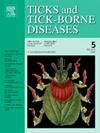Diversity and prevalence of spotted-fever group rickettsiae in ixodid ticks across Slovakia, Central Europe
IF 3.4
2区 医学
Q2 INFECTIOUS DISEASES
引用次数: 0
Abstract
Habitats with the sympatric occurrence of several ixodid tick species are significant from an epidemiological perspective. These habitats can influence the diversity and prevalence of tick-borne pathogens, and their monitoring can help estimate the risk of infection. A total of 1260 questing ticks from five species (Ixodes ricinus, Dermacentor marginatus, Dermacentor reticulatus, Haemaphysalis concinna, and Haemaphysalis inermis) were collected from vegetation using the flagging method in three different habitats in eastern Slovakia. Additionally, 900 rodent-attached ticks of six species (I. ricinus, Ixodes trianguliceps, D. marginatus, D. reticulatus, H. concinna, and H. inermis) collected from 149 small mammals belonging to seven species (Apodemus flavicollis, Apodemus agrarius, Microtus arvalis, Myodes glareolus, Micromys minutus, Crocidura leucodon, and Crocidura suaveolens) were selected for molecular analyses. DNA obtained from rodent-attached and questing ticks was tested by nested PCR targeting the gltA gene to determine the presence of Rickettsia spp. The ompA, ompB, and sca4 genes were amplified and sequenced to identify rickettsiae species. The overall prevalence of rickettsiae in questing and rodent-attached ticks was 12.5 % and 20.0 %, respectively. Overall studied localities, the most diverse spectrum of rickettsiae species, including R. helvetica, R. monacensis, R. raoultii, and R. slovaca, was recorded in questing and rodent-attached ticks in the natural habitat of the Slovak Karst. The dominant species, R. helvetica (62.9 %), was identified in two species of questing and rodent-attached ticks, specifically I. ricinus and H. concinna, and in rodent-attached D. reticulatus ticks. Rickettsia raoultii (20.4 %) was identified in questing and rodent-attached D. marginatus, D. reticulatus, and in questing H. concinna. Additionally, this study provides the first input of pathogenic R. raoultii in I. trianguliceps obtained from the striped field mouse (A. agrarius). Rickettsia monacensis (9.0 %) was detected in questing and rodent-attached I. ricinus, while Rickettsia slovaca (3.6 %) was found in questing and rodent-attached D. marginatus ticks. Natural biotopes with different tick species and hosts significantly affect the diversity and prevalence of rickettsiae.
中欧斯洛伐克境内蜱虫中斑点热群立克次体的多样性和流行
从流行病学角度看,几种蜱类同地分布的生境具有重要意义。这些栖息地可以影响蜱传病原体的多样性和流行,对它们的监测可以帮助估计感染的风险。采用标记法在斯洛伐克东部3个不同生境的植被上共采集到蓖麻蜱、边缘革蜱、网状革蜱、细血蜱和无血蜱5种蜱1260只。选取7种149只小型兽类(黄斑姬鼠、黑线姬鼠、小仓鼠、光斑姬鼠、小仓鼠、小仓鼠、小仓鼠、小仓鼠、小仓鼠、分钟仓鼠、白纹仓鼠、小仓鼠)6种(蓖麻蜱、三角仓鼠、边缘仓鼠、网纹仓鼠、细仓鼠、小仓鼠)的900只啮齿蜱进行分子分析。采用巢式PCR方法检测附鼠蜱和寻鼠蜱的gltA基因,并扩增ompA、ompB和sca4基因序列,确定立克次体的种类。调查蜱和附鼠蜱中立克次体总体流行率分别为12.5%和20.0%。总体而言,在斯洛伐克喀斯特自然生境中,立克次体物种分布最为多样,包括helvetica、monacensis、raoultii和slovaca立克次体。在捕鼠蜱和贴鼠蜱(蓖麻蜱和灰蜱)和网纹蜱(贴鼠蜱)中,均鉴定出优势种helvetica(62.9%)。在猎鼠和附鼠的边缘田鼠、网纹田鼠和猎鼠鼠中鉴定出拉乌尔立克次体(20.4%)。此外,本研究提供了从条纹田鼠(A. agrarius)获得的三角纹田鼠(I. trianguliceps)中首次输入致病性拉乌尔氏伊蚊。在捕鼠和附鼠的蓖麻蜱中检出单纳克次体(9.0%),在捕鼠和附鼠的边缘蜱中检出慢行立克次体(3.6%)。不同蜱类和寄主的自然生态环境对立克次体的多样性和流行率有显著影响。
本文章由计算机程序翻译,如有差异,请以英文原文为准。
求助全文
约1分钟内获得全文
求助全文
来源期刊

Ticks and Tick-borne Diseases
INFECTIOUS DISEASES-MICROBIOLOGY
CiteScore
6.90
自引率
12.50%
发文量
185
审稿时长
6-12 weeks
期刊介绍:
Ticks and Tick-borne Diseases is an international, peer-reviewed scientific journal. It publishes original research papers, short communications, state-of-the-art mini-reviews, letters to the editor, clinical-case studies, announcements of pertinent international meetings, and editorials.
The journal covers a broad spectrum and brings together various disciplines, for example, zoology, microbiology, molecular biology, genetics, mathematical modelling, veterinary and human medicine. Multidisciplinary approaches and the use of conventional and novel methods/methodologies (in the field and in the laboratory) are crucial for deeper understanding of the natural processes and human behaviour/activities that result in human or animal diseases and in economic effects of ticks and tick-borne pathogens. Such understanding is essential for management of tick populations and tick-borne diseases in an effective and environmentally acceptable manner.
 求助内容:
求助内容: 应助结果提醒方式:
应助结果提醒方式:


